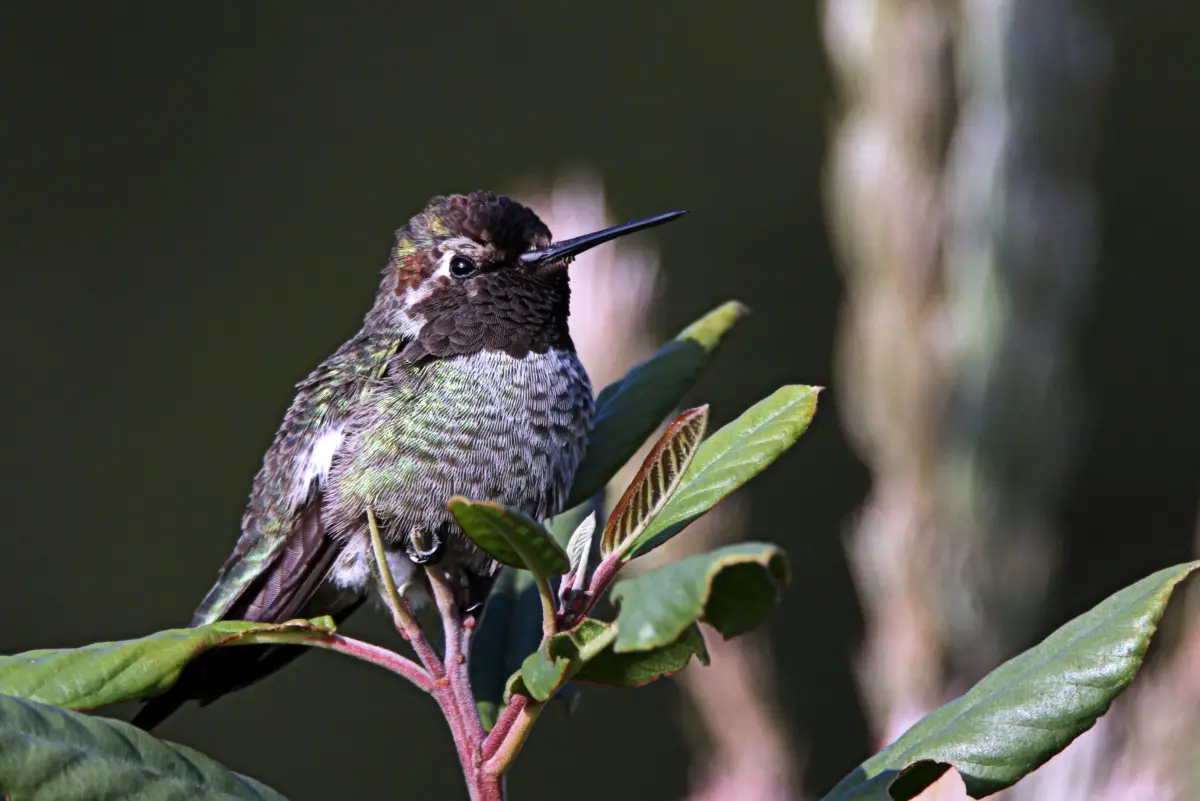This post contains affiliate links.
While riding my bike and stopped at a traffic light, I noticed an odd shape fluttering on the ground. As I looked further, I realized it was an injured adult hummingbird. I started thinking, is the hummingbird still alive? Is it safe for a human to touch a hummingbird? Who do I call for hummingbird assistance?
These questions prompted further inquiries on future predicaments dealing with baby hummingbirds falling out of nests and/or hand-feeding hummingbirds.
Understanding the answers to these questions will help a hummingbird enthusiast like me, feel confident in taking safe and swift action in any precarious situation where a hummingbird is harmed or leaning on death’s door.
Is it safe for a human to touch a hummingbird?
You will not get sick or catch diseases by touching a hummingbird. There are no laws preventing a hummingbird from touching you however, it is illegal to trap, hold, or control a hummingbird without a permit. Therefore, you are perfectly within your legal rights and it is safe to pick up a hummingbird if it is in distress or to hand feed a hummingbird.
From a legal standpoint, the Migratory Bird Treaty Act of 1918 in the United States declares, possession or capture of any migratory bird without a permit is illegal. This applies to hummingbird nests, babies and eggs.
Violation of this law will result in the hummingbird being immediately removed with a fine of $15,000 to $200,000 in US dollars.
View a summary of the Migratory Bird Treaty Act of 1918 law…..
The Department of Fish and Wildlife is the only department that has the legal authority or is permitted access to handle, protect and manage the states’ fish, wildlife, native habitats, and plants.
Overthinking a situation can become more trouble than it’s worth. Go with your first instinct when locating a distressed hummingbird or having a hummingbird touch you while you hand feed them without fear of breaking the law.
Knowing what to do in an emergency situation or just experiencing and enjoying a hummingbird’s presence is in itself rewarding.
Finding a Distressed Adult Hummingbird
When finding yourself in a precarious predicament in regards to a distressed hummingbird or in an emergency situation, follow these 3 easy steps.
Step 1
Assess the situation and check to see if this sick, injured or distressed hummingbird is alive and breathing or if it is dead?
Remember when hummingbirds are trying to conserve energy or are in shock they will go into torpor which is the same action they use when they fall asleep every night. When hummingbirds are in a state of torpor it may look like they are dead when in reality they are not.
Sometimes it takes 20 to 30 minutes to verify if the hummingbird is still alive before making a judgment call.
Step 2
Once the hummingbird is established as being alive, cup your hands together and scoop the tiny fragile hummingbird and place it in a shoebox with a shaped nest made out of a towel lined with paper towels and layered with tissues.
Larger birds can handle the weight of a single towel. Delicately framed hummingbirds need a softer material to support and stabilize their small bone structure. Make sure the lid has ventilating holes at the top of the box before transporting.
Step 3
Call your local veterinarian, wildlife rehabilitator or animal rescue that is trained in aiding hummingbirds immediately for further assistance and guidance. The first four hours from the time the distressed hummingbird is located to getting care is crucial for the survival of the hummingbird.
It is best to get the distressed hummingbird to a rescue center as soon as possible and let the professionals nurse it back to health rather than attempting to make your own nectar and trying to feed the hummingbird. Every second of every minute counts!
Finding a Distressed Baby Hummingbird
Complete the same guide for a distressed adult hummingbird as mentioned above with a few exceptions when finding a distressed baby hummingbird.
Exception 1
If you are at the park or on a bike ride and are not at home, make sure the baby hummingbird receives aid immediately. When out in the community or wild habitat, it becomes harder to locate where the baby came from or where the nest is located.
Exception 2
Depending on the developmental stage of a baby hummingbird, they need to be kept warm. Newborn babies are naked with no pin feathers and require immediate attention since they cannot regulate their own body temperature.
An adolescent hummingbird that is older can regulate its body temperature more readily and can afford more minutes to pass than a newborn, but will still need assistance for survival.
Exception 3
Many people talk about feeding a distressed hummingbird with sugar water before transferring them to a professional since they need to feed so frequently.
The ratio of sugar to water is 1 to 4 and the magic number for hummingbird survival is 4 hours.
It sounds like a simple and logical response to a difficult situation, but stop and think for a moment… What do you have at home?
- Do I have a syringe?
- Do I have sugar and distilled water?
- Does my living situation allow the baby hummingbird to acquire 24 hours of constant heat to stay warm?
- Do I have the time required to feed the baby hummingbird every 10-15 minutes around the clock?
Unless we are professionals or help animals for a living, most people will not have these items in their house on a regular basis. When that is the case adding time to go to the store to acquire these tools only adds more minutes and the countdown of time for the life of a baby hummingbird.
In my experience, this process takes too long. The sooner you can acquire assistance the better chances of survival for the hummingbird.
If you have these tools readily available at your disposal and feel confident to live up to the challenge then you may feed a baby hummingbirds sugar water up to 4 hours with an eyedropper or syringe before they need the help of a trained professional.
In the early stages of a baby hummingbird’s life, they must consume more protein than nectar. Without a constant food supply of protein, they can become ill and die, hence letting a professional handle the situation and getting assistance within that critical time frame is extremely important
Fallen Hummingbird Babies From Nest
Many of us have witnessed a baby bird that has fallen out of the nest and has yet hoped to never have to be put in a situation of having to decide the fate of a distressed animal. Trepidation can set in and you may ask, what do we do? It is always scary to think their lives are in our hands!
Don’t panic and take a deep breath. A distressed baby hummingbird may be on the ground from accidentally being kicked out of the nest by a sibling. They were probably in the last stages before flight and were using their wings to practice flying or there was a terrible storm with heavy wind and rain knocking them out of the nest and onto the ground.
Mother hummingbirds will not abandon their young if they have been handled by humans. This is a common myth. Hummingbirds have no sense of smell, however, if she does not come back to her nest in the next 30 minutes to 1 hour after you have returned the baby or the naked hatchling to the nest, get assistance right away.
If the baby is older in their developmental stages and has pin feathers do not panic and continue to wait for the mother to return. Use your best judgment when assessing the situation.
Naked chicks lose their heat quickly and their internal body temperature easily drops since they do not have any feathers to keep themselves warm. The heat from your hands that is transferred to the chick even in the short amount of time it takes to put the baby back in the nest saves lives despite feeling insignificant.
If the mother takes too long in returning to the nest do not cloud your mind with doubt and believe it is because you touched the baby with your bare hands. It is extremely easy and convenient for your mind to be fooled and tell you that it was a mistake to touch a baby hummingbird, but don’t believe it, it is not true!
In any of these situations, the number one goal is to get the baby hummingbird safely back in its nest.
If you happen to be unsuccessful in returning the baby hummingbird quickly back to the nest or the mother hummingbird does not return to the nest the time frame is roughly again between 30 minutes to 1 hour, contact your local animal rescue center for assistance.
Hand-Held Hummingbird Feeders
A popular pastime activity is training a hummingbird to feed from your hand. Feeling the tight grasp of tiny hummingbird feet grip on your skin is a very rewarding experience.
To begin, attract hummingbirds to your backyard by adding a multitude of hummingbird friendly flower producing plants.
Introduce plenty of large feeders to your backyard. Make homemade hummingbird nectar to fill your feeders with these two simple ingredients, sugar and water. When mixed correctly it best resembles the natural nectar found in flowers. Mix and dissolve 1 cup of granulated white sugar into 4 cups of spring or filtered water.
When an abundance of hummingbirds locate your feeders, start spending more time outside so they will become familiar with your company (about 20 min a day).
Stay patient and do not be discouraged if they are easily frightened. It will take some time and they will eventually warm up to your presence.
Once they do and realize you are not a threat but actually are the friendly hand that feeds them, they will stay longer and feed on the plentiful/bountiful flowers you have provided in your area.
When you have gained a significant amount of traffic in your feeding area remove the larger hummingbird feeders and add a red closed top hand-held feeder to your space. Before you know it, you will have more than one friendly face competing for space to drink out of your hand.
Read my post on How To Train A Hummingbird To Feed From Your Hand…..
It is not illegal if a hummingbird touches you but it is illegal to capture a hummingbird without a permit. Therefore, be comfortable in the knowledge that training a hummingbird to feed from your hand or touching a hummingbird if it’s in distress is perfectly legal and hygienically safe.
Happy Hummingbird Saving!
Backyard Visitors participates in affiliate programs which compensate us for referring traffic.


